Recession? What Recession ask the bankers!
November 26, 2010 at 9:48 am | Posted in Political Economy, World Politics | Leave a commentTags: 21st Century Capitalism, Political Economy, US Economy, US hegemony, US politics, world politics, World-economy
Earlier this month, Lord Young of Graffham, the 78-year old ‘enterprise advisor’ to British Prime Minister David Cameron was forced to retire after claiming that most Britons “never had it so good” in this ‘so-called recession’ because interest and mortgage rates were so low! If his comments were politically too difficult for the Coalition government in Britain, it was at least true for bankers and financiers in the UK and the US. Though trading is down and Congress is tightening regulations, Wall Street firms are setting aside large sums as bonuses. According to Nomura, the Japanese bank, five Wall Street firms–Goldman Sachs, Morgan Stanley, Citigroup, Bank of America, and JP Morgan Chase–are setting aside $89;54 billion this year for its employees’ bonuses even though revenues for the firms fell by 4 percent.
While the bonuses will not be paid till January 2011 as the financial firms assess their performance in the fourth quarter, luxury purchases are booming and The Lion, a new restaurant that opened in New York;s Greenwich Village in May, recently sold a bottle of Chateau Mouton Rothschild for $3,950. Though public outrage has led firms to scale back on corporate excesses like private jets and corporate retreats, personal indulgences have come roaring back.
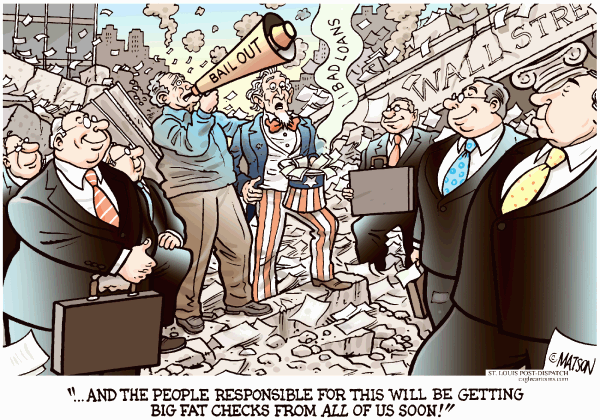
While much of the attention has been focused on the top executives who make the 19th century ‘robber barons’ look like petty juvenile delinquents–Goldman Sachs’ chief executive, Lloyd Blankfein pocketed a cool $68.5 million in pay and shares in 2007–this has obscured the fact that lower-level employees making between $100,000 and $200,000 receive hefty year-end bonuses. Wall Street firms typically set aside 40 to 50 percent of their revenues as bonuses.

In the bizarre logic of Wall Street, if firms do not pay top bonuses to their employees even if the firms post losses, the employees will jump ship to a competitor willing to pay higher bonuses or salaries. This is of course a case of inverted logic: if the employee was responsible for losses, why not let the employee go–or better yet, fire and blacklist the employee?

And now that the Republicans have won control of the US House of Representatives, they are clamoring to make the Bush era tax cuts permanent. Though Candidate Obama had campaigned on a platform that promised to end the tax cuts for those earning over $200,000, there are signs that the White House will now cave in to Republican demands or at the very least extend them for another two years.
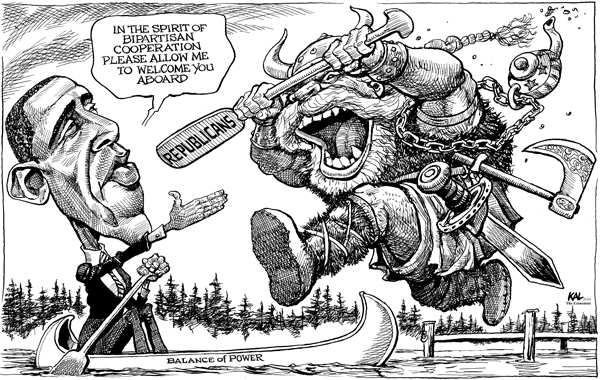
Despite the media claiming that the Democrats’ loss of approximately 60 seats in the House of Representatives was a “bloodbath”–to which President Obama concurring by admitting they received a “shellacking”–if the overall percentage of votes cast for the two parties are examined, John Kane noted, the Democrats received 47.3 percent of the vote and the Republicans 50.1 percent: hardly a “shellacking”. Moreover, only 38.2 million of the eligible voters cast their ballots–hardly a case of the “American people” rejecting the President’s message. In fact, the reason for the large fall in the percentage of eligible voters exercising their franchise in the 2010 mid-term elections may precisely be because they did not see the Democrats making a difference. After all, the $700 billion bailout may have secured the health of the financial sector–and guaranteed the return of good times to the financiers–but has done little to ease unemployment.

Hence, it would clearly be a mistake for the Democrats to throw in the towel and cave in to Republican demands. But perhaps it is too much to expect of this President!
Israel and the US: Tail wagging the dog
November 20, 2010 at 9:58 pm | Posted in Human Rights, International Relations, World Politics | Leave a commentTags: international relations, interstate system, Israel, Middle East, Palestine, United States, US hegemony, US politics, world politics
One of the many paradoxes of the recent mid-term elections in the United States is that foreign policy did not intrude into the campaign rhetoric even though the country is engaged in two major wars in Iraq and Afghanistan. Nevertheless, even as Republicans continued to question whether President Obama was even an American citizen, the second-ranking Republican Congressman and Majority Leader-elect, Eric Cantor promised the visiting Israeli Prime Minister Benjamin Netanyahu that he would defend Israel against his own government–a promise that as Glenn Greenwald wrote in salon.com moved even the Jewish Telegraph Agency‘s Ron Kampeas to note:
I can’t remember an opposition leader telling a foreign leader, in a personal meeting, that he would side, as a policy, with that leader against the president. Certainly, in statements on one specific issue or another — building in Jerusalem, or somesuch — lawmakers have taken the sides of other nations. But to have-a-face to face and say, in general, we will take your side against the White House — that sounds to me extraordinary.

And of course, the Obama Administration was not unduly pressuring the Israelis! A year ago, President Obama had demanded a freeze on Israeli settlements which extended even to what was blithely called “natural growth” of existing settlements. But on the very same day that Representative Cantor met Prime Minister Netanyahu, Secretary of State Hilary Clinton promised the Israeli leader $3 billion worth of fighter bombers in return for a 90-day moratorium in building settlements on the West Bank excluding East Jerusalem–that is to say a bribe of $3 billion to halt illegal activity and stealing other people’s land for 3 months! An act of appeasement if there ever was one, as Robert Fisk scathingly noted and an appeasement all the more egregious when the US economy is in the worst shape it has been since the 1930s and Americans everywhere are urged to tighten their belts. In the same week, as the bipartisan National Commission on Fiscal Responsibility and Reform recommended a wide-ranging plan to cut the federal deficit affecting virtually every sector of US society, there were no recommendations to cut aid to Israel. Cantor had, in fact, proposed last month that aid to Israel not be classified as ‘foreign aid’ to shield it from cuts even as Americans suffer cuts in welfare, farm subsidies, jobs, etc.
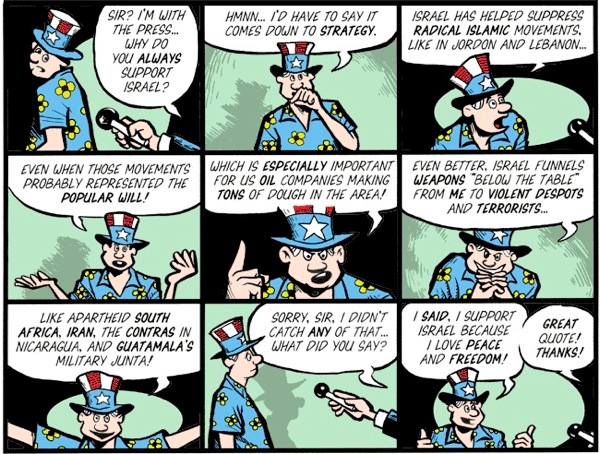
It is clear that the newly-energized Republicans will be even more pro-Israel than the current administration (much as that might boggle the mind) even though Israeli repression of Palestinians is a direct threat to the national security of the United States as admitted by the top US general in Afghanistan, General David Petreus. When the Obama Administration has lacked the spine for a fight even when the Democrats controlled both houses of Congress, Republican gains in the mid-term elections is likely to ensure a continuing stalemate in the ‘peace process’ and effectively ruling out a two-state solution as illegal Israeli settlements make it impossible to construct a viable Palestinian state.
If ever a super-power is hobbled, it is here in the US relations with Israel. Unable to defend its own national interests, it has become a vassal of a smaller state!
Of course, as the history of peace negotiations have long illustrated, a two-state solution was never a viable option as the Israelis always demanded that the Palestinian state be non-militarized and Israel demanded control of acquifers. But as the Palestinian population continues to grow and they cannot be shunted out–Israel’s existence as a Jewish state becomes increasingly untenable.
Puppets Turning Against Puppet Masters
November 18, 2010 at 10:35 am | Posted in International Relations, Political Economy, World Politics | Leave a commentTags: Afghanistan, Asia, military, United States, US hegemony, world politics
If the failure of President Obama to wrest any meaningful concessions from the major economies at the G-20 summit in Seoul underlined the incoherence of US economic policy–with many economists admitting that a weaker US dollar would not increase employment–Afghan President Hamid Karzai’s sharp criticism of US military policies underline the incoherence of its occupation of Afghanistan.
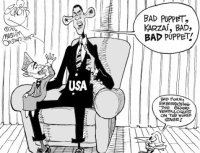
As the almost decade-long occupation has failed to pacify the insurgency which is, in fact gathering such steam that NATO forces are transporting Taliban leaders to Kabul to meet with the Karzai regime to negotiate a cease-fire, the US commander in Afghanistan escalated night-time raids to about 200 a month–more than 6 times the level 18 months ago. Whereas US Special Operations forces were carrying out an average of 5 raids a night as recently as last July, in the three months before November 11, they were conducting an average of 17 raids a night leading to the death or capture of 368 ‘insurgent leaders’ and the death of 968 ‘other insurgents’ and the capture of an additional 2,477 according to NATO sources. ”Many Afghans see the raids as a flagrant, even humiliating symbol of American power,” some New York Times correspondents reported, “especially when women and children are rousted in the middle of the night.”
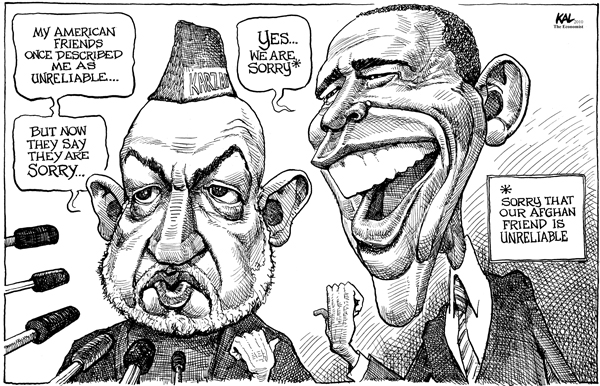
Finally, last Saturday, in an interview with the Washington Post, President Karzai sharply criticized the massive increase in night-time raids and said that US and NATO failure to respect the sanctity of Afghan homes was fuelling the insurgency. Karzai turning against his US patrons is ironic since he was parachuted into the Afghan presidency precisely because he was seen as a complaint figure. And indeed, in his first appearance as the Afghan Interim President before the US Senate Foreign Relations Committee, we sat like a minor provincial satrap while the Senators sat on an elevated platform and quizzed him as one would an errant schoolboy
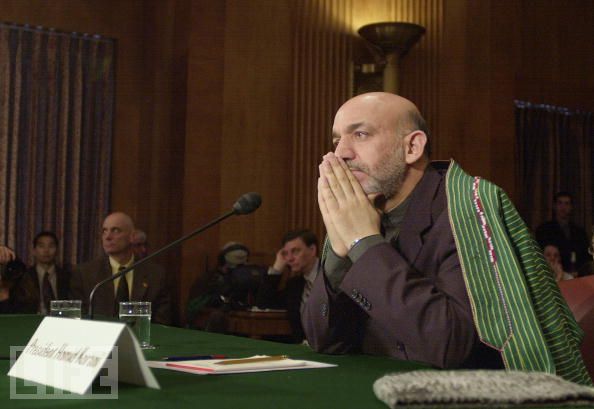
But as the occupation continues, for his own survival he recognizes that he has to assert some autonomy from the incoherent military policies of the Occupation forces. Though he holds office only at the pleasure of the United States–his recent “electoral” win was questionable and in any case the Afghan armed forces are no match for the insurgents–he knows that the US cannot forsake him as they have no other ‘leader’ in the wings to take over. Thus, last April when he was pressured by the US to reform his administration, he even brazenly threatened to “join” the Taliban!
What is perhaps more surprising, given Karzai’s earlier protests against US policies, is that General Petreus could only respond by registering his “astonishment and disappointment” at Karzai’s pointed criticism. What is astonishing about noting that the killing of civilians, the rousing of women and children in the dead of the night, the violation of the sanctity of private homes is a humiliating reminder of the powerlessness of the Afghans, and that continued humiliations fuels the insurgency?
Appearing before the British parliament’s foreign affairs committee, Sir Sherard Cowper-Coles who served two terms as ambassador to Afghanistan, said that army commanders who told their superiors that the military strategy was not working were told to make their reports more optimistic and that the Afghan government was much less popular in the country’s south than the Taliban who were seen as ”a fairer, more predictable alternative than a corrupt and predatory government.”
Afghanistan is not merely a military quagmire from which a face-saving exit is now almost impossible, but it is also turning to be a bottomless money pit. One recent audit found that between 2007 and 2009, the Pentagon, the US Agency for International Development, and the US State department gave $18 billion to some 7000 contractors and that they cannot account for much of this money or to whom it was given! Other reports show that police stations, hospitals, schools and other buildings that were to have been constructed were so badly built that they are unusable. Louis Berger, a New Jersey construction firm, was assessed a fine of $69.3 million in fines for overbilling the government for things like a music system in its Washington DC offices for money that were to have been for reconstruction in Afghanistan!
Competition, Trade, Currencies, and Economic Summits
November 14, 2010 at 1:52 pm | Posted in International Relations, Outsourcing, Political Economy, Production, World Politics | Leave a commentTags: 21st Century Capitalism, China, international relations, Manufacturing, United States, US Economy, US hegemony, US politics, world politics, World-economy
Far more fundamental that the charges and counter-charges of currency manipulation and trade imbalances traded at the November 2010 G-20 summit in Seoul to a shift in the terms of global economic competition was an announcement that the Commercial Aircraft Corporation of China, or Comac, plans the introduction of a 156-seat single-aisle passenger jetliner. The entry of China into the commercial passenger aircraft industry is noteworthy for two reasons.
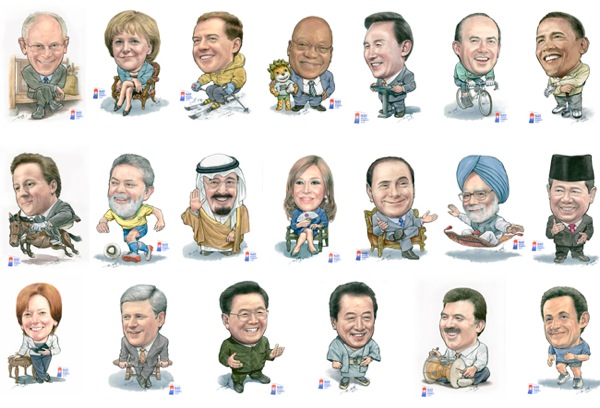
First, most of the technology for the Chinese C919 plane will be provided by Western companies. The plane’s computer system, brakes, wheels, and power units by Honeywell; its navigation systems by Rockwell Collins; avionics by GE Aviation; fuel and hydraulics by Eaton Corporation; and flight controls by Parker Aerospace. These companies have agreed to a Chinese stipulation that they set up joint ventures with Chinese companies. Though the companies claim that they will safeguard their intellectual property, David Pierson suggests that the example of high-spreed rail proves otherwise. After European and Japanese firms shared their technology with their Chinese joint venture partners, they are now in direct competition with their former Chinese partners both in and out of China.
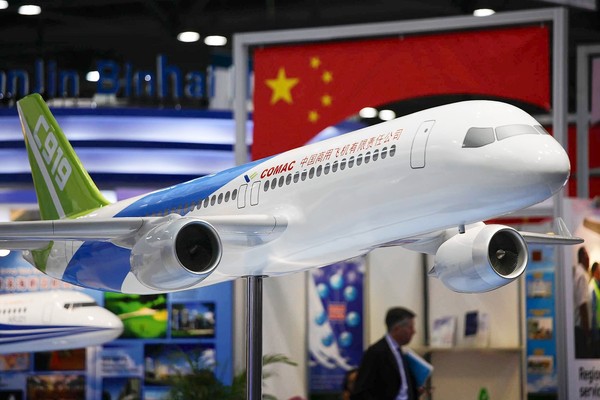
Yet, projections of China’s rapid rise compels there Western aviation companies to bid aggressively for the Chinese market. In the next twenty years, Chinese air traffic is expected to grow at an annual average rate of 8 per cent a year and to meet this demand the country’s domestic airlines are estimated to purchase some 4,330 planes worth $480 billion over the same period. No supplier of aviation parts wants to miss out on this lucrative market.
If the sheer size of its market confers a competitive advantage on China in technology transfer, it is also the case that 55% of Chinas exports are accounted by foreign-owned companies. Moreover, China’s large current account surpluses with the United States and the European Union is matched by large deficits with other countries as shown by a recent article in the Financial Times. In many cases, transnational production and procurement networks span across national borders to take advantage of wage and cost differentials and a substantial part of China’s exports are only assembled and packaged there from components made elsewhere. This means that these foreign-owned companies are not particularly receptive to calls for China to revalue its currency–or indeed, the attempt by the US Federal Reserve to force down the value of the greenback by releasing $600 billion to buy US Treasury bonds: what a former Chairman of the Fed, Alan Greenspan termed “a policy of currency weakening.”
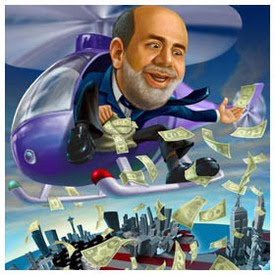
Devaluing the dollar by releasing more greenbacks is “clueless” as the German Finance Minister Wolfgang Schäuble called it because it would raise the cost of living in the United States when the unemployment rate is hovering at double digits and is unlikely to create a spurt in job growth in the United States. In fact, though President Obama trumpeted that his visit to India would create 54,000 jobs in the US, that is merely a third of the jobs created in the country in just the last month as Alan Beattie noted in the Financial Times.
In part, trade imbalances have taken center-stage because during the financial meltdown in 2008 and 2009, trade contracted sharply and thereby reduced trade imbalances as Floyd Norris noted in the New York Times. A modest recovery however highlighted the imbalances and governments began to accuse each other of undervaluing currencies.
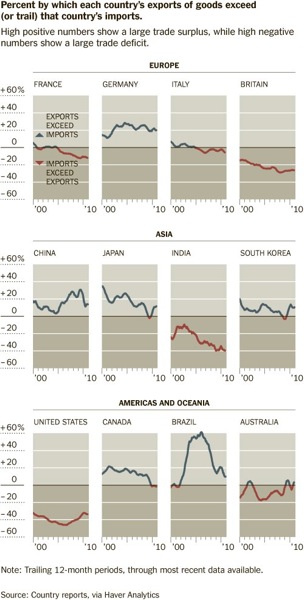
Such charges and counter-charges ignore the changes in competitive pressures. With the greater deployment of automated technologies and numerically-controlled machines, and the Taylorization of even skilled work, wage charts increasing resemble a time-glass: fewer and fewer extraordinarily well-paying jobs, and more and more sub-subsistence jobs as indicated in several prior posts. These underlying conditions can be addressed only in the long-run through well developed plans that do not respect two-year electoral cycles which is the focus not only of Washington politicians but also of the US punditocracy!
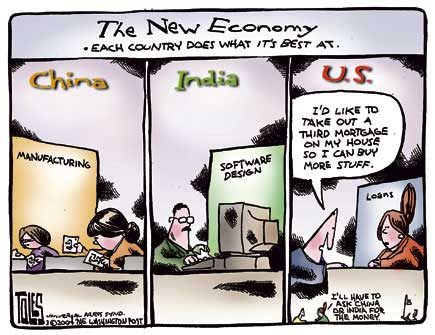
The one remaining competitive advantage the United States has is that its currency is the only reserve currency but if the Fed devalues the dollar–and already uncertainties in currency markets has led to the price of gold soaring to $1,400 a troy ounce–as Robert Zoellich, the President of the World Bank, has suggested it is likely to lead to multiple reserve currencies. And that will seal the end of the United States as an economic superpower.
A Defining Partnership or a Post-dated Check?
November 9, 2010 at 10:26 pm | Posted in Human Rights, International Relations, Political Economy, World Politics | Leave a commentTags: Australia, China, Human Rights, India, international relations, interstate system, Middle East, Palestine, Political Economy, US hegemony, world politics
President Barack Obama’s declaration that relations between the United States and india will be a ‘defining partnership‘ of the 21st century and that the United States will support India’s quest for permanent membership in the UN Security Council may have been exactly what the Indian political elite wanted to hear but it eerily resembles the Cripps Mission sent by the Churchill government to enlist the support of the Indian National Congress and the Muslim League as belligerents in the Allied war effort against Nazi Germany and its allies.
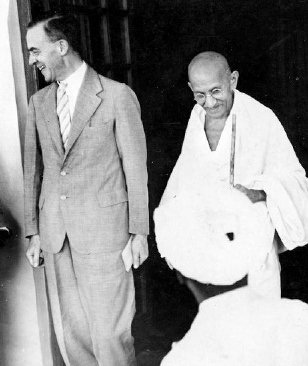
Just as Sir Stafford Cripps came with the offer of full Dominion status to India if it joined the Allied war effort, President Obama said that he saw India being a permanent member of the UN Security Council sometime in the future. Not only was Obama not specific about when this would happen–and since it depended at the very least on the agreement of the four other veto-bearing members of the Security Council, he was in no position to offer a timetable unlike Cripps–but what it would entail. Indeed, the current members of the Security Council jealously guard their veto privileges and would not easily surrender it nor admit other veto-bearing powers to their ranks.
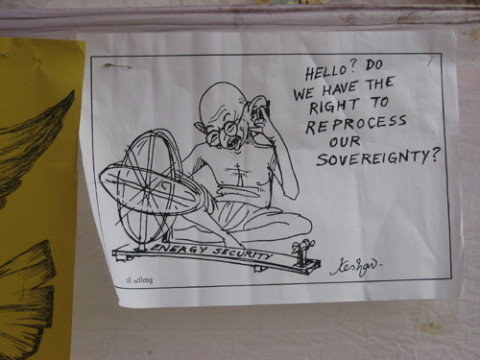
At the same time, with breath-taking arrogance President Obama declared that India must play a ‘responsible’ role in world affairs–chiding India for not speaking up against Burma’s military rulers. This was echoed by an editorial in the Los Angeles Times: “India’s government has seldom acted in the interest of the world, and humanity, when doing so might clash with its own economic interests. Nowhere is this more apparent than on India’s border, where New Delhi is coddling a repressive military junta in Myanmar. India’s trade ties with this brutal regime, and its silence on human rights abuses there and elsewhere around the world, don’t recommend it for greater influence in the United Nations.”
And yet, US abuses of human rights are legion: Obama’s predecessor, George W. Bush, still defends water-boarding as not being torture. The last few US administrations have wantonly killed hapless civilians: Madeleine Albright, President Clinton’s Secretary of State, said that the death of half a million Iraqi children as a result of sanctions imposed after the end of the first Gulf War was worth it in a 1996 60 Minutes interview, George W. Bush’s murderous assault on Iraq and Afghanistan killed hundreds of thousands of Afghans and Iraqis, and Obama has escalated the use of drones to indiscriminately kill Pakistani villagers on the Afghan border. When has the United States spoken about Israeli abuses against the Palestinians…and the list goes on.
While Obama was calling the US-India partnership as a ‘defining relationship, his Secretary of State Hillary Clinton was defining the US-Australia alliance as a “core partnership” and explicitly calling for Australia to relegate its relationship to China–a country that accounts for 23 percent of its exports–to a secondary partnership because of the shared ideals between the two countries.
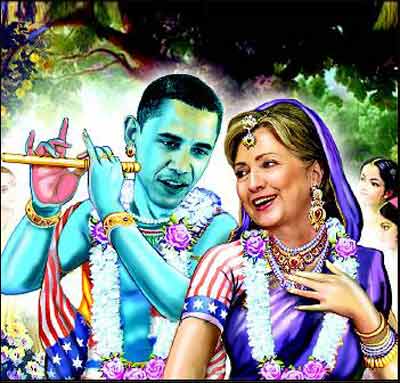
She said, “And it is important to recognise that just because you increase your trade with China or your diplomatic exchanges with China, China has a long way to go in demonstrating its interest in being – and its ability to become – a responsible stakeholder.” Once again, the US sets itself as the arbiter.
Yet, what has the US got to offer India? Much as the Indian political elite wishes for a permanent seat with veto powers in the UN Security Council, that is not in the power of a US President to bestow–and even if it were, how ‘great’ can a country be if its ‘greatness’ is bestowed by some other power as a favor?
If Obama plays up to the aspirations of the Indian elite, it is to enlist them in an alliance to check the rise of China–and in tandem, Hillary Clinton was given the easier chance of recruiting Australia, one of the more slavish allies of the US.
It is a pity that Manmohan Singh and other Indian leaders did not tell Obama, as Gandhi told Cripps, that his offer is ‘a post-dated check on a failing bank!’
A Third Wave of Outsourcing?
November 6, 2010 at 6:32 pm | Posted in Labor, Outsourcing, Political Economy, Production | 3 CommentsTags: 21st Century Capitalism, China, India, labor process, Manufacturing, trade wars, US Economy, US hegemony, World-economy
Persistently high unemployment figures in the United States have led to strident calls by politicians about ‘unfair’ trading practices by China, India, and other countries and demands to curb outsourcing of US jobs to lower wage locations overseas. Much of the discussion, especially in the context of President Barack Obama’s 10-day visit to Asia, has focussed on low-cost manufacturing in China and white-collar service work to India, a new type of outsourcing pioneered by Amazon.com’s Mechanical Turk service just five years ago, represents the potential to transform outsourcing in some sectors. This represents a further assault on incomes.
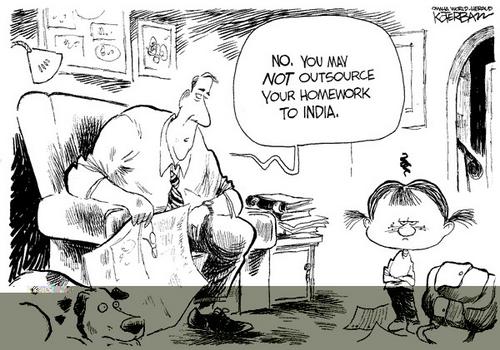
Claiming to take the tedium out of repetitive, monotonous tasks that are notoriously difficult to automate (recognition of handwritten messages or numbers, for instance), a handful of companies are creating software to further deskill digital labor. Essentially, these companies–Microtask, CloudCrowd, Cloudflower, and others–break up tasks into many different component parts both to shield the identity of their clients (as each worker gets to see only a miniscule portion of the document and therefore cannot identify the real client) and to lower labor costs by widely distributing the tasks: Cloudflower claims to have a virtual workforce of 500,000 people in 70 countries while CloudCrowd which was formed only in 2009 claims a virtual workforce of 25,000 and says it has completed 2 million tasks by September 2010 according to its promotional video.
Companies take different approaches. Microtask, a Finnish upstart, contracts with firms and provides software to its clients’ employees which enables them to do a small task–recognition of handwritten numbers, comparison of two images of a product, few minutes of speech transcription–without leaving their computer screen to get more information from the Internet. The software rotates and mixes up the tasks so that there is no monotony while the main computers of the client can compile the tasks performed by its employees–leading to an unprecedented level of control while minimizing the possibility of leaks.

Other companies directly contract with individual workers. At the Mechanical Turk website, there are are number of tasks on offer and once a person performs a test to show his or her talent at a job–identifying business locations, proof-reading, and such like–they can sign up and do tasks steadily at their own pace and when they want to work. However, Randall Stross reports in the New York Times that when Miriam Cherry, a law professor at the University of the Pacific and her research assistant tried an assignment offering 2 cents “each for finding the contact information of 7,500 hotels and 3 cents each for answering questions about 9,400 toys,” they did not even make the minimum wage!
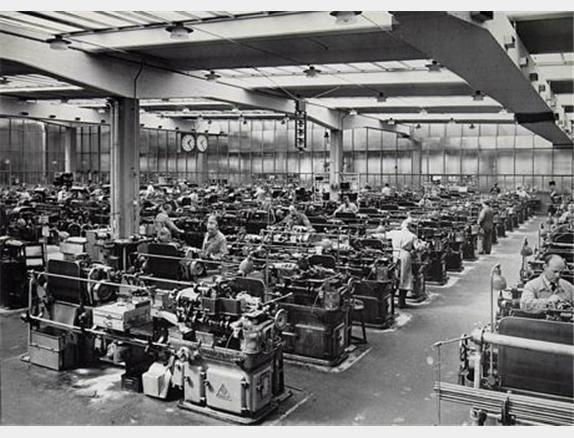
As Stross notes, “Worker control is precisely what the Microtask model has engineered out–that’s the source of its insidious efficiency. Just as Ford’s assembly lines a century ago brought work to workers who performed a single, repetitive task, Microtask’s software, via the Internet, does the same. Every two seconds.”
Yet, the so-called ‘cloudsourcing’ (from the Internet ‘cloud’) model is different in crucial respects. By farming out work across the planet, companies do not have to confront organized labor–protests against low wages become infinitely more difficult if workers are spread across many, many jurisdictions. Cloudcrowd, for instance, takes translations of business documents that used to be done by a single person and initially submits it to translation software. The software translation is then broken up into pages and sent to people who look for nonsensical sentences. These are then submitted to native speakers and finally to editors who have no special expertise in the language, but simply make the text more readable. By farming out the work to several unconnected individuals, anonymity is assured and translation costs are minimized–from 20-25 cents a word to just 6.7 cents. And, of course, minimum wage legislation would not apply.
![640_fiat_hot_autumn__69[1].jpg 640_fiat_hot_autumn__69[1].jpg](https://rpalat.files.wordpress.com/2010/11/640_fiat_hot_autumn__6911.jpg?w=300&h=217)
Even if these widely-distributed tasks do not earn minimum wages in the United States and other high-income economies, they beat the minimum wage in many low-income countries and hence many of the workers for Cloudflower and other ‘cloudsourcing’ companies are located in places like Malaysia and the Philippines. Seen in this light, too, it is not surprising that the new president of the State University of New York at Albany, George M. Philip, could eliminate the departments of Italian, French, Russian, Classics, and Theatre without hesitation!
Circle of Democracy?
November 3, 2010 at 9:03 pm | Posted in democracy, international relations, Political Economy, world politics | Leave a commentTags: Asia, China, India, Indonesia, international relations, Japan, South Korea, US hegemony, Vietnam, world politics
President Obama’s 10-day trip to Asia this month comes at a time of increased tensions between China and its neighbors in East Asia over off-shore territories and increased military spending by the Chinese government. This has provided the US government with a wedge to ‘re-engage’ with Asia and promote a ”circle of democracy” between India, Indonesia, Japan, South Korea, and the United States. ‘Democracy’ is a warm fuzzy word that is hard to oppose but a closer examination of the nascent alliance is disconcerting
Territorial disputes in the South China were cast in sharp relief in early September when a Chinese fishing trawler fishing along the coasts of Senkaku Islands (called Diaoyu in Chinese and claimed by Japa, Taiwan, and China) collided with Japanese Coast Guard vessels. The hawkish Japanese Minister of Land, Infrastructure, Transport, and Tourism. Maehara Seiji ordered the Coast Guard to arrest the captain of the Chinese trawler, Zhan Qixiong. Maehara’s actions may have propelled him to the Foreign Ministry within a fortnight of this incident, but his hawkishness prompted a vigorous Chinese response. They cancelled, as Peter Lee notes, scheduled bilateral talks on undersea oil and gas exploration and airline flights. Travel agents were instructed not to accept reservations by Japanese tourists and embargoed exports of rare earth oxides to Japan as well as detaining four employees of a Japanese firm on charges of espionage. Eventually, the Japanese Prime Minister had to step in and order the release of Captain Zhan. However, humiliating this incident may have been to Japan, it provided a windfall to the United States as China’s neighbors were increasingly alarmed by Beijing’s willingness to use its military and economic clout to advance its interests.

This disquiet among the small East and Southeast Asian states was aggravated by rising Chinese military expenditures–though these are still far smaller than US outlays on the military. Nevertheless, the expansion of the Chinese navy and the fact that China now has an aircraft carrier under construction has raised concerns amongst its neighbors and Vietnam is now seeking closer relationships with its old adversary–the United States. Vietnam is also concerned by Chinese dam constructions that could limit the flow of water downstream to the Mekong River–and the US has exploited the opportunity by creating a Lower Mekong Initiative.
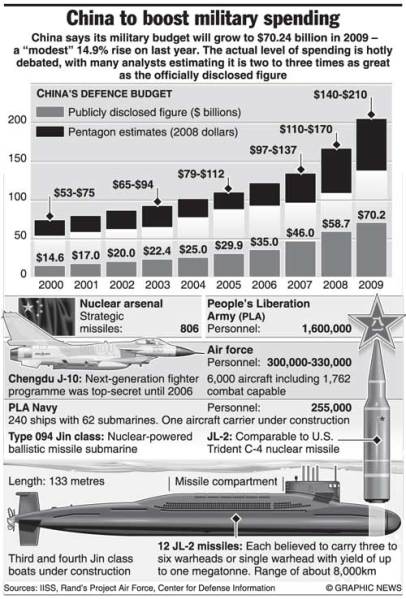
Meanwhile, after having initially made some overtures to China, the Obama White House change tack and adopted an increasingly antagonistic posture to China: even though the United States refused to commit to greenhouse gas emission limits, it demanded that China give up the favorable terms it had secured in the Kyoto Protocol. It demanded that China sacrifice its energy security and enlist in a Western crusade against Iran. And it is being pressured to appreciate its currency to resolve US current account deficits.
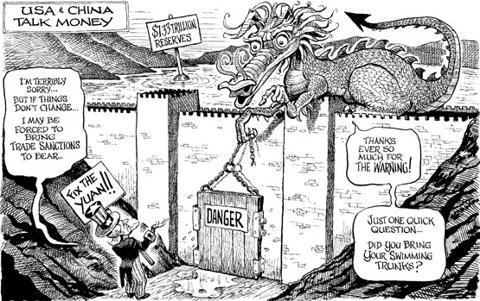
This set the stage for the United States to forge an alliance in Asia with India, Indonesia, Japan, and South Korea–and despite protestations to the contrary, all alliances are against another power–and in this case, China. Dubbed the ‘circle of democracy,’ it is attractive to Japan and South Korea–two American client states without a strong military presence–and cautious of China flexing its muscles; to Indonesia which has a large Chinese minority that has been persecuted, most notably in 1950, in 1965-67, and again in 1997-98; and to India seeking a global role. Rhetorically, it is billed as an alliance of democracies ringing an ‘authoritarian’ state.
Democracy is a warm, fuzzy word and one can no more be against democracy than against a teddy bear! And yet, democracy masks a variety of practices–mere electoral democracy does not translate into substantive rule of the people. In the United States, elections have become so expensive that politicians are deep in the hock to moneybags and hence there is little difference between the two parties. In India, it has not translated into power to the people, and more recently even the freedom of the press has come under attack, especially in Maharashtra by the Shiv Sena where they pressured the Vice Chancellor of Bombay University to withdraw Rohinton Mistry’s book, Such a Long Journey, from the prescribed list of books even though neither the protesting Sainiks nor the Vice Chancellor had read it!
For the US, President Obama’s visit to India has a clear objective: to sell advanced fighter planes and other arms to India–along with India’s indigenously developed aerial reconnaissance capabilities (AWACS), it will allow India to project its power regionally in support of US objectives–but not to seriously obstruct the United States. The US economy, despite projected Indian purchases of planes and weaponry remains weak and unable to sustain its imperial role. Its unparalleled nuclear capabilities have been shown to be useless in the wars in actually has to fight–in Iraq and Afghanistan. The Indian Ocean is a crucial trade route–some 70 percent of the world’s oil passes through it and a large and growing part of world trade. And it is a arena where the Chinese are increasingly active–building naval base in Gwadar in Pakistan near the Straits of Hormuz and building alliances with Sri Lanka, Bangladesh, and Mauritius, Here, the US seeks to court India as a subordinate ally–and last year US forces trained more with the Indian military than with the militaries of any other state–to perform ‘low end activities’ for the US: search and rescue, humanitarian assistance, disaster relief. high-value cargo escort–so that the US can concentrate on the ‘high-end’ activities.
Obama’s India Visit
November 1, 2010 at 8:05 am | Posted in Political Economy | Leave a commentTags: Asia, Global South, India, international relations, interstate system, US hegemony, world politics
Projections that the Republicans will make substantial gains in the midterm elections add significance to President Barack Obama’s visit to India during the Diwali weekend. The visit was to focus on two issues: the economy and geopolitics.
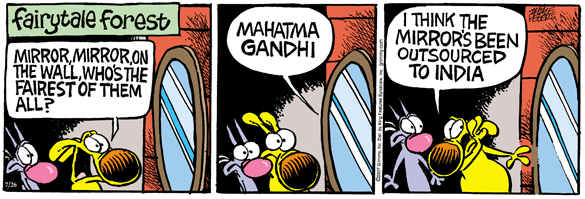
To underline the importance of economics and to tap into India’s growing market, President Obama–unlike the four other US presidents who have visited India–will begin his visit in Mumbai, the country’s business capital and will spend more time there than in New Delhi. He is also bringing with him a bevy of some 250 CEOs of US corporations as the US seeks increased access to Indian markets not only for the large transnational corporations but also for small- and medium-scale enterprises. Reflecting domestic US concerns about outsourcing jobs to India, unlike his immediate two predecessors, President Obama will not travel to the information technology centers of Hyderabad and Bangalore. And, because so many in the US continue to believe that their president is a Muslim, despite all evidence to the contrary, President Obama has also eschewed a visit to the holiest of Sikh gurdwaras–the Golden Temple in Amritsar–as he would have to cover his head and this may be construed by the rabid right-wing in the United States as him being Muslim!

While Indian capitalists bristle at allegations that they use unfair trade practices to take jobs away from Americans and resent restrictions placed on the employees they can send to the US, they are also more closely linked to the United States than ever before. For one thing–partly to ensure access to high-level contacts–they have been making substantial donations to US universities. Ratan Tata donated $50 million to Cornell University in 2008 and followed it up with a $50 million donation to the Harvard Business School last month–the largest international private donation in the institution’s 102-year history. Several other Indian industrialists–Nandan Nilekani, Anand Mahindra. N. R. Narayana Murthy, among others–have made substantial donations to US universities–and strikingly none to more cash-strapped Indian institutions of higher learning.
Apart from seeking access to US policy makers, these donations reflect close family relationships with US universities–many of the industrialists and their children have studied in the universities that are now the recipients of their largesse. Indeed, most Indian middle- and upper-class families have relatives now living in the US, most of them working in the software, financial, and engineering sectors and fully supportive of US policies. Perhaps the most indicative sign of the growing influence of US “soft” power was the recruitment of Washington Redskins cheerleaders to provide a model for Indian cheer leaders in that most un-American game: cricket (though cricket was once the preferred bat-and-ball game among colonists in what is now the US!). And shamefully, India was only one of three countries–the others being Israel and the United States–where there was popular support for the US-led invasion of Iraq in 2003.
This congruence of strategic interests gains added significance in the light of likely Republican gains in the US midterm elections. Many Republicans have expressed their opposition to ‘nation-building’ exercises in Afghanistan and yet a resolution to the ongoing problems in Afghanistan continues to be elusive. Just last week, a joint raid on opium producing facilities by NATO, the Russians, and the Afghan Interior Ministry’s Counter-Narcotics Police Sensitive Investigative Unit and National Interdictive Unit was denounced by President Hamid Karzai as “a blatant violation of Afghanistan’s sovereignty.”
Leaving aside, Karzai’s chutzpah, India is an obvious partner to the US in Afghanistan: it is already the largest regional donor to Afghanistan and is eager to increase its role there to gain “strategic depth” against Pakistan and to emerge as a regional power. Republican opposition to foreign aid also provides an opportunity for India to step up its aid to Africa and show that it is more than a regional power–that its tentacles spread beyond the South Asian region. Of course, it is deeply ironic that the Indian government is stepping in to provide aid to Africa when not only do many Indian states fall below many African states in the Global Hunger Index but many Indian companies are now buying land or leasing land in Africa to export crops back to India. Surely, for sheer immorality, exporting food from an chronically food-deficient continent cannot be beaten. But such ironies are lost on the policy-making establishments!
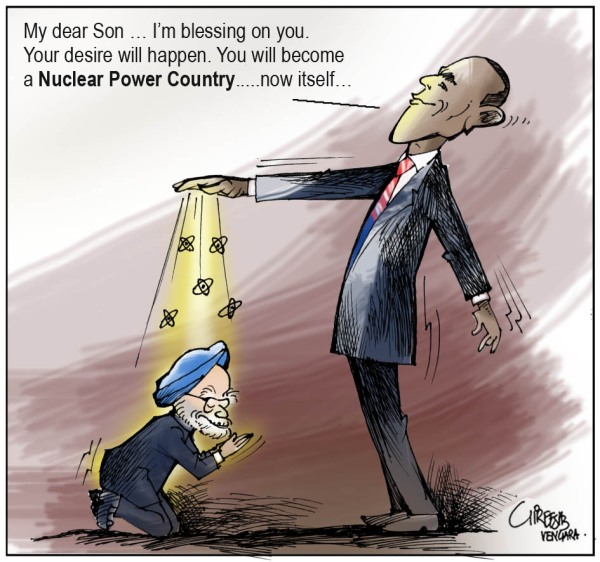
For the Indian government, partnership with the United States is essential for India’s emergence as a global power–though what that says about the nature of its ‘global power’ if such status depends on another (the US) is never discussed! For the United States, given its enduring difficulties in Afghanistan and Iraq, and a continued economic downturn at home, India provides a counterweight to China. President Obama had come to office seeking a strategic partnership with China and last year, in his first visit to Asia after assuming office, his speech on Asian Security in Tokyo did not even mention India–a factor which probably led to him having Prime Minister Manmohan Singh as guest for his first state dinner at the White House.
Since then, increasing difficulties with China, and China’s assertive stance towards its neighbors and a brief stoppage in the export of rare earths to Japan, the US, and increasing Chinese incursions into the Indian Ocean have shifted US foreign policy perceptions. Hence, it is now willing to sell advanced weaponry to India to cement ties between the two countries and of course to boost the US domestic economy.While the Indian political leadership welcomes these initiatives, what they would most like to see is unambiguous and strong US support for a seat as a permanent member of the UN Security Council. This is unlikely, though President Obama may sponsor India’s membership in the Nuclear Supplier’s Group (NSG) formed by an angry US administration in 1974 after India’s first ‘peaceful’ nuclear explosion to deny India dual-use nuclear technology.
Create a free website or blog at WordPress.com.
Entries and comments feeds.
